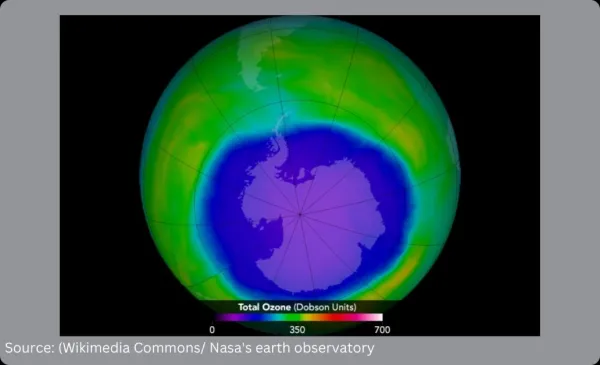By: Christian Haag
June 15 2023

Studies have shown that bans on CFCs have reduced the hole in the ozone layer, and it is on track to be replenished by the mid-twenty-first century.
Context
Claims have been made on social media that the hole in the ozone layer has repaired itself and that its existence was a manufactured emergency and a hoax.
The ozone layer is a region in the upper atmosphere containing a high concentration of ozone molecules and blocks harmful solar radiation. The layer has built up over time and is believed by scientists to have played an essential role in the development of life on Earth. The amount of ozone in the layer results from the creation and destruction of ozone molecules and winds transporting ozone molecules worldwide.
The claim is part of a narrative downplaying the threat of climate change and that changes are natural instead of man-made.
In Fact
However, the claim is false. The hole in the ozone layer began to shrink after combined global efforts to ban chlorofluorocarbon (CFC) chemicals after the Montreal Protocols in 1987.
In the 1970s, scientists began to observe that human emissions affected the ozone layer. Paul Crutzen found that nitrogen oxide could react with free oxygen atoms and slow ozone creation. Building on this research, Mario Molina and F. Sherwood Rowland found a connection between CFCs contributing to chlorine levels in the stratosphere and found that chlorine could destroy ozone when subjected to UV radiation. Scientists later discovered a similar reaction with bromine. In 1985, it was discovered there was a hole in the ozone layer in the Antarctic.
Additional research revealed substantial evidence of a correlation between chlorine and bromine in the stratosphere, released from CFCs and halocarbon – present in refrigerators, aerosols, and air conditioners, among other products – proving that the ozone depletion was real and significantly impacted by human activity.
In 1987, scientists and politicians met in Montreal to draft the Montreal Protocol. The protocol outlined a framework to phase out ozone-depleting substances such as CFCs. 46 countries initially signed it, and it now has 200 signatories. The protocol succeeded: with 99 percent of ozone-depleting substances phased out, the ozone layer started to replenish, with the hole over Antarctica expected to close by 2066.
NASA reported in October 2022 that the ozone hole continues to shrink, although recent events have increased emissions, slowing replenishment. In 2019, an increase in CFC emissions was traced to eastern China, which the country has blamed on “rogue manufacturers.” A 2023 study found that smoke particles from Australian wildfires in 2019-20 increased the size of the ozone hole in Antarctica due to fire aerosols reacting to factories’ CFC emissions.
The Verdict
There is substantial evidence that human activities have contributed to both repairing and depleting the ozone layer and hole. There is no evidence that the ozone hole “repaired itself.” We have therefore marked the claim as false.